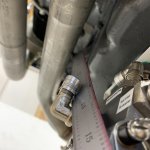I would like to route my -4 fuel line from the servo to the spider up between the #1 & #3 cylinders (it currently runs up the back). I have a vertical sump with a vetterman exhaust. I need to run the -4 line between the sump and the exh cross-over pipe right in front of it. I have about 1.5" of clearance. The fuel line is a PTFE type with integral firesleeve. the hose will cross the exh pipe at a 90* angle
I can make a little stand-off to keep the hose about 1/2" away from the pipe. I can also wrap the hose with heat reflective material and/or additional firesleeve. Will this be enough to keep it from melting? Any other ideas to protect it? I can make a heat shield, but the hose will be touching the heat shield, so not sure it helps.
I appreciate any guidance or suggestions you may have.
Larry
I can make a little stand-off to keep the hose about 1/2" away from the pipe. I can also wrap the hose with heat reflective material and/or additional firesleeve. Will this be enough to keep it from melting? Any other ideas to protect it? I can make a heat shield, but the hose will be touching the heat shield, so not sure it helps.
I appreciate any guidance or suggestions you may have.
Larry






